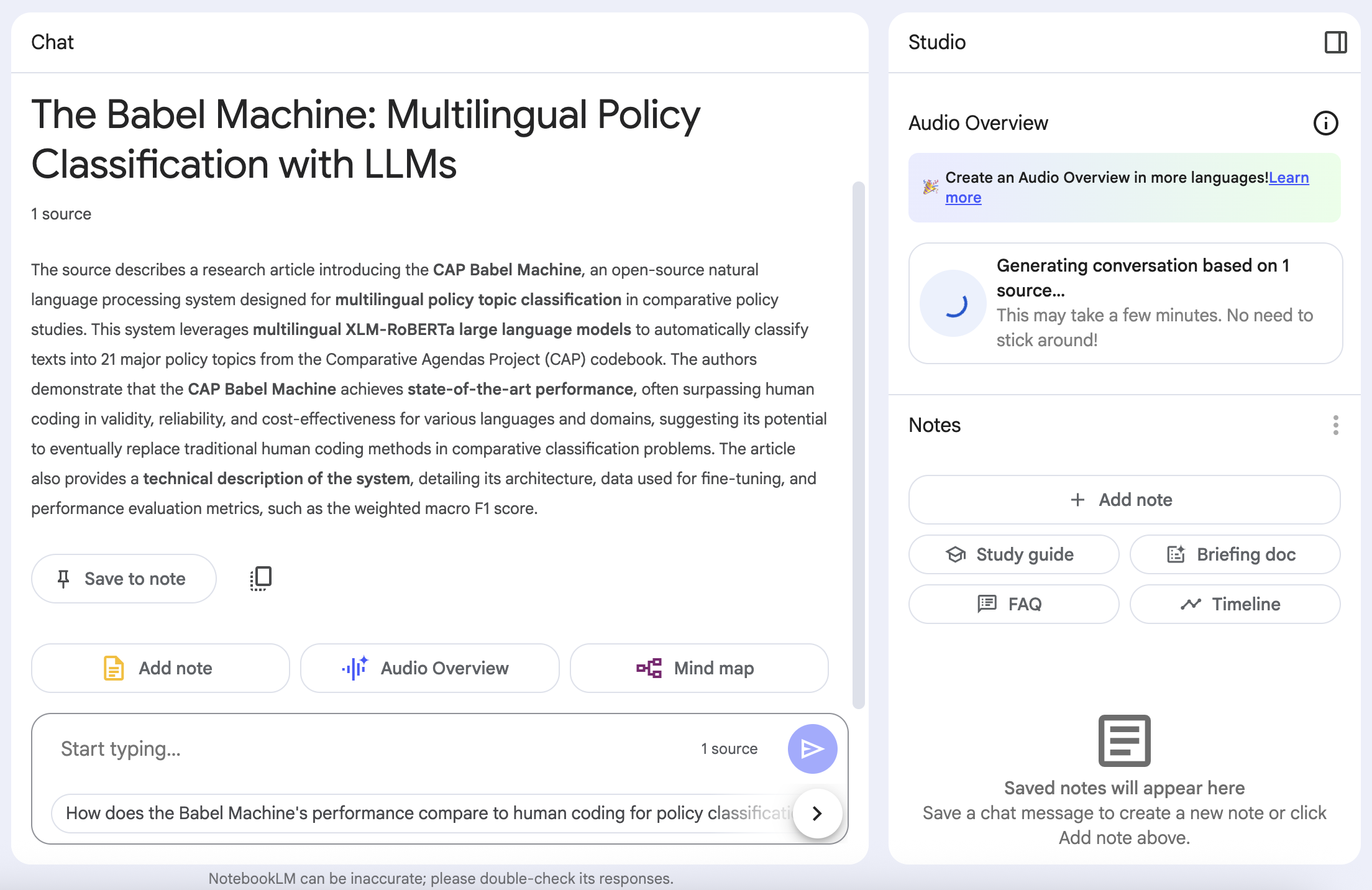In an earlier post, we tested Gemini’s Audio Overview as a tool for open science, examining its capacity to transform written research into accessible spoken summaries. While that experiment revealed both strengths and limitations, it also raised the question of how other AI systems address the same task. Notebook LM’s Audio Overview offers a somewhat different model: it similarly produces dialogues between AI hosts, but with more flexibility for tailoring the discussion, generating longer variants, and incorporating user-directed prompts. In this post, we put Notebook LM to the test on the same type of research material, comparing its performance to Gemini’s approach and evaluating its potential contribution to research dissemination in open science.
Input file
For this test we supplied a single input: Sebők, M., Máté, Á., Ring, O., Kovács, V., & Lehoczki, R. (2024/2025). Leveraging Open Large Language Models for Multilingual Policy Topic Classification: The Babel Machine Approach. Social Science Computer Review, 43(2), 295–317. Notebook LM first generated a brief text overview of the paper and, within minutes, produced an Audio Overview—a dialogue-style summary playable in the interface that captured the article’s core contribution, methods, and findings. We turn next to the extent of customisation and how this experience differs from Gemini’s Audio Overview.

Configuration
Notebook LM’s Audio Overview offers a significantly higher degree of customisation than Gemini’s more basic implementation. Users can select from four distinct formats — Deep Dive (a conversational unpacking of the material), Brief (a short, bite-sized summary), Critique (an expert-style review offering constructive feedback), and Debate (a dialogue highlighting different perspectives on the same sources). In addition, the length of the audio can be adjusted to Shorter, Default, or Longer, allowing the same source material to be explored with varying levels of detail.

The feature also supports multiple languages, enabling the audio to be generated not only in English but in a wide range of other supported languages, which makes it accessible to diverse audiences. Finally, the model can be guided to focus on a particular source, topic, or target audience — for instance, by asking it to explain the material to someone entirely new to the field. Together, these options make Notebook LM’s audio output much more flexible and adaptable than Gemini’s fixed-format summaries.
Output
The English version produced a natural-sounding interview-style dialogue that clearly captured and summarised the central arguments of the article. The complete audio can be listened to below.
We also tested the Audio Overview in Hungarian. While the generated voice sounded somewhat mechanical and abbreviations or technical expressions were often mistranslated, the model nonetheless managed to capture the essence of the article and delivered a coherent summary. Compared to the English version it was noticeably weaker in terms of fluency and naturalness, but it still provided a useful overview that conveyed the main arguments of the text.
Recommendations
Notebook LM’s Audio Overview demonstrates real potential both as a research aid and as a dissemination tool. For researchers, it offers a convenient way to engage with scholarly work while on the move, or to grasp the essentials of technically demanding articles without reading them in full. At the same time, the generated dialogues can serve as valuable instruments of public communication: by presenting complex studies in accessible spoken form, they provide a bridge to wider audiences and make research outputs more easily shareable beyond academia.
The authors used Google NotebookLM [Google (2025) NotebookLM (accessed on 1 August 2025), AI-powered research assistant, available at: https://notebooklm.google] to generate the output.






